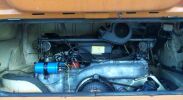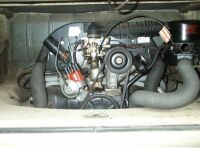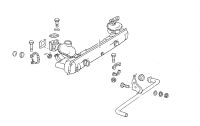Mechanical areas to check - Page 3
Click any image to enlarge
Drive shafts
All Bay-Window vans use
double jointed drive shafts at the rear to transmit torque from the gearbox to
the wheels.
Again, the drive shafts are very strong like most parts on the Type 2 if a few
simple precautions are carried out. Check that the drive shaft gaiters are
intact. The gaiters protect the constant velocity joint from dirt and water and
contain the grease within the joint. If the gaiters have become loose or split,
it is likely that most of the grease will have been pushed out and water and
dirt entered, decreasing the life of the joint. You may be lucky with a damaged
gaiter where no damage to the joint has occurred and a fresh gaiter and grease
is all that is required.
Checking for wear is difficult. When moving off from rest, listen for a
knocking from the rear. Raise and spin the wheels, listening and feeling for
harshness. Grip the shaft and try to move it. Is there any movement? Even if
there is a little movement, as long as the joint is greased and covered they
can last many more years until they fail.
Clutch
The clutch should be light
and easy to operate. The bit point when raising the pedal should be between 1/2
to 3/4 of the way up.
To check the clutch, try pulling away from rest in 3rd gear. If the engine
speed rises but the vehicle speed does not, then the clutch is slipping and
will need replacement due to wear or oil contamination. It is quite common for
the rear crankcase seal to leak oil onto the clutch. This usually has the
effect of making the vehicle judder as you release the clutch as the clutch is
gripping and un gripping the flywheel.
The cost of a new clutch assembly is low - ranging from £53 - £91 depending on
engine type from
but involves the removal of
the engine to replace it, which is not difficult but takes a few hours and
really needs 2 people to complete safely.
Gearbox
The gearbox rarely wears and
will take a huge mileage if the oil level has been maintained at the correct
level. The gearbox design is very similar to the gearbox used in the Beetle but
the 2 are not interchangeable. My 1974 van has completed 210,000 miles still
giving no signs of problems. Touch wood!!
Look for evidence of oil leaks, excessive noise, especially on the over-run and
jumping out of gear when moving. Difficulty in finding gears is usually down to
alignment of the shifter plate (
) under the gear stick or
wear in the bushes within the very long linkage. The rubber bush that connect
the gearbox to the linkage is the first to wear but it costs around £25 ( for 3
rubber bushes!!) and takes under 1 hour to change.
Engine
The Bay Window van used 2
basic configurations of engine. The T1 upright 1600cc. based on the Beetle
engine or later 1700,1800 and 2000cc. engines from the T4 saloon car range.
 Both engines are air-cooled which means that oil
changes are of the upmost importance as the oil does the majority of the
cooling. Being air-cooled, the engines are noisy as they don't have water
jackets to insulate noise so listen carefully for abnormal noises. Noise from
the centre of the engine indicates wear in the big end bearings, while noise
from the head area could be tappets that need adjusting or wear in the rocker
assembly. To be able to identify these noises you need to know what a good
engine sounds like! It sounds simple but takes experience. Go to VW shows and
find an engine that is new or has been re-built and compare the noise to an
engine that you know is worn.
Both engines are air-cooled which means that oil
changes are of the upmost importance as the oil does the majority of the
cooling. Being air-cooled, the engines are noisy as they don't have water
jackets to insulate noise so listen carefully for abnormal noises. Noise from
the centre of the engine indicates wear in the big end bearings, while noise
from the head area could be tappets that need adjusting or wear in the rocker
assembly. To be able to identify these noises you need to know what a good
engine sounds like! It sounds simple but takes experience. Go to VW shows and
find an engine that is new or has been re-built and compare the noise to an
engine that you know is worn.
 A good indication of wear on the 1600cc. engine is the
amount of movement at the crank shaft pulley that turns the fan belt. Hold the
pulley (engine off) and push and pull. There should only be the slightest
amount of movement. Any more movement than 0.15mm indicates wear in the rear
thrust bearing.
A good indication of wear on the 1600cc. engine is the
amount of movement at the crank shaft pulley that turns the fan belt. Hold the
pulley (engine off) and push and pull. There should only be the slightest
amount of movement. Any more movement than 0.15mm indicates wear in the rear
thrust bearing.
Look at the engine. Is it clean and tidy? Are all the cooling seals in place?
You should not be able to see the floor from within the engine compartment. If
you can see that seals or tinware are missing then the engine has probably over
heated at some point and damage may have occurred. Look for excessive oil leaks,
especially on the floor were the van is usually parked. All these engines tend
to leak compared to a modern engine as the crankcase is split in half which
cannot help. Look especially around the push rod tubes as these have a habit to
leak.
Start the engine from cold. Check for smoke. Blue smoke indicates burning oil
which means it could need new piston rings, pistons and barrels. Black smoke
indicates excessive petrol which means the carburetor is incorrectly adjusted
or worn. If left for too long, excessive petrol while also expensive, causes
the cylinder barrels to wear as protective oil is washed away by the petrol.
Take a look at the carburetor, does it look stained. Staining indicates worn
throttle spindles which allow fuel out and air in, resulting in poor
performance.
Check the fuel lines in the engine bay for cracks and missing clamps. When
looking at the engine you are looking for a general impression that it has been
well maintained. It should be clean, no bits of tape holding things together,
wiring placed tidily. Again, only experience can help here but the engine
should start easily, idle smoothly, not smoke and rev. freely when driving.
The VW air cooled engine is not the greatest engine for power but they are
reliable if looked after. If the engine does seem worn, do not be put off. Use
it as a negotiating point as all parts are still available. The 1600 engine is
much cheaper to repair than the T4 engine as parts are still being manufactured
by for VW in
Heater/Exhaust system
As
all Bay-Window Type 2`s are air cooled, heat for the cabin is recovered from
the hot exhaust gases by heat exchangers. The exhaust manifolds have fins cast
into the manifold body which radiate the heat from the gasses passing through
the inside of the manifold.  These fins are surrounded by a metal cover forming the
heat exchanger, which connects to ducts to the cabin interior. Later T4 engined
models had an additional fan that pushed air through the heat exchanger,
increasing the rate of flow to the cabin. The heat exchangers connect to the
exhaust system which is basically one large silencer and pipe work compressed
into a small area. Check for rust and holes visually on the heat exchangers.
You should be able to hear noise caused by holes on the silencer. Cover the
exhaust tail pipe with a cloth while the engine is running. The engine should
die as the exhaust gases cannot escape and pressure builds up. If there are any
leaks in the system you will here the exhaust gases escaping.
These fins are surrounded by a metal cover forming the
heat exchanger, which connects to ducts to the cabin interior. Later T4 engined
models had an additional fan that pushed air through the heat exchanger,
increasing the rate of flow to the cabin. The heat exchangers connect to the
exhaust system which is basically one large silencer and pipe work compressed
into a small area. Check for rust and holes visually on the heat exchangers.
You should be able to hear noise caused by holes on the silencer. Cover the
exhaust tail pipe with a cloth while the engine is running. The engine should
die as the exhaust gases cannot escape and pressure builds up. If there are any
leaks in the system you will here the exhaust gases escaping.
Heat exchanger cost around £60 each with original and better quality exchanger
costing around double. Original heat exchangers typically last longer and give
out more heat than the cheaper pattern varieties. T4 engined heat exchangers
are even more expensive which is also true for exhausts which vary in price and
quality from £40 to £200 plus for a stainless steel system.
T1 exhausts are a real pain to fit and can take 2-3 hours to fit as they never
go back together as they came off, plus all the nuts have a habit of rusting
solid.
Click here to return to previous page.